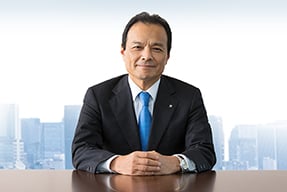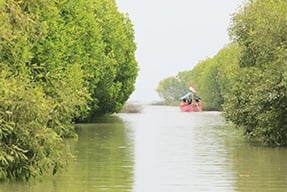Described below is the summary of Q&A session with institutional investors and securities analysts at the FY2012 2Q results conference call held on November 19, 2012.
- Q1Regarding the impact from Hurricane Sandy, you explained that net incurred losses in group total is, as estimated at present, to be approximately 30.0 billion yen (10.0 billion yen at TMNF and 20.0 billion yen at overseas subsidiaries). It seems like an excessive amount compared to the total insurance market loss estimated by cat modellers. Are there any special factors behind it?
- A1
Hurricane Sandy caused various damages by wind, flood, and business interruption due to power failure, and a large portion of such damages is hard to estimate numerically. At present, the claims reported on-site are only a part of the expected incurred losses and some time is required before we can grasp an accurate loss level. Based on cat modellers' loss estimates, we estimate losses in adjusted earnings in international insurance business at approximately 14.0 billion yen at this point, which is factored in our revised FY2012 projections.
As for the relative loss level in comparison with the market loss, we believe it's too early to discuss it in the current stage where great discrepancies exist among the estimated total loss amount by multiple cat modellers which is also subject to change over time. In addition, loss estimates announced by other insurance companies are also based on various assumptions and still subject to change.
For your information, out of the 10 billion yen of incurred losses estimated at TMNF, approximately 7 billion yen is marine-related. - Q2Regarding auto insurance, unit claims cost for vehicle damage and property damage liability coverage seems to be on a rising trend. From which quarter have you been recognizing this trend? In addition, how will this trend affect the second half?
- A2
The rise in unit claims cost for those coverage has become visible since around 4Q FY2011, largely affected by the rise in unit repair parts cost. We project this effect to continue throughout the second half of FY2012.
- Q2(2)Do you mean the impact from the higher unit claims cost is to become larger in the second half?
- A2(2)
No. Our projections are based on an assumption that the trend in the first-half will continue at the same level throughout the second half.
- Q3In TMNF's revised projections for the full-year, ordinary profit is revised upward by 1.0 billion yen despite the large impairment losses on securities in the first-half. Considering the fact that underwriting profit is projected to be at the same level as the original projections, I guess capital gains are revised upwards. Do you plan to accelerate the sales of business-related equities in the second-half?
- A3
Although it depends on stock market conditions, at present, there is no change in our original plan of selling more than 50 billion yen of the business-related equities in FY2012.
- Q4In 2Q FY2012, the expense for the new claims service system is recorded as a loss adjustment expense. Are similar costs also expected in the second half and/or next fiscal year and beyond?
- A4
As for the current fiscal year, majority of the expenses related to the new claims services system has been already recorded in the first-half, and the remaining cost of roughly 0.8 billion yen is projected to be recorded in the second half. As for the next fiscal year and beyond, a certain amount of the cost related to the claims service system is projected, to be more precise, the cost is approximately 8.0 billion yen for FY2013 and FY2014 in total.
- Q5Full-year projection of adjusted earnings for domestic life business is revised downward by factoring in effects of the expected increase in consumption tax rate. As a result, are there any possibilities of revising the mid-term target of aggregate EV increase of 180 billion yen in three years total?
- A5
We do not plan to revise the target in our mid-term business plan at this moment. As for the revised projections for FY2012, following the enactment of the bill to raise the consumption tax rate, we have factored in its impact into the assumptions of the unit cost for EV calculation, which will have a negative impact of 3-4 billion yen at TMNL.
- Q6I believe the upcoming January is the timing for reinsurance policy renewals. What is your view on the rate trend considering the effects of Hurricane Sandy?
- A6
Considering cat modellers' loss estimate for the entire insurance market, we do not think that the impact from Hurricane Sandy would harden the reinsurance market as a whole. Hurricane Sandy would have an impact on our reinsurance business results in the short term, however, our views on profitability in underwriting North America's natural catastrophe risks have not changed. In the mid-long term, we will diversify our risk portfolio through underwriting non-cat risks in the course of business development.
- Q7You have explained that the appreciation of the yen was one of the reasons for the downward revision of your full-year projections, mainly in international insurance business. My understanding is that, the yen's appreciation contributed as a profit-increasing factor in group total mainly due to a decrease in provision for reserve for foreign-currency-denominated outstanding claims at TMNF. Does the yen's appreciation affect negatively to earnings under the current business portfolio as a result of the expansion of international insurance business? In addition, please tell me the FX sensibility in the event of a one-yen appreciation against the US dollar.
- A7
There is no change in our business structure of the yen's appreciation contributing as a profit-increasing factor in group total. In 2Q FY2012, the yen's appreciation resulted in i) a decrease in provision for reserve for foreign-currency-denominated outstanding claims and ii) gains on derivatives at TMNF. Each of these had a positive impact of approximately 2.0 billion yen respectively (before tax). On the other hand, at US dollar-dominated overseas subsidiaries, the yen's appreciation worked as a profit-decreasing factor by approximately 0.2 billion yen. Therefore, in group total, the yen's appreciation resulted in a profit increase by approximately 3.8 billion yen (before tax).This positive impact in the first half is factored in on TMNF's revised projections.
(Reference)
FX sensitivity as of 30 Sep, 2012 in the event of a one-yen appreciation against the US dollar is:- i) an increase by approx. 2.0 billion yen; owing to a decrease in provision for reserve for foreign-currency-denominated outstanding claims
- ii) an increase by approx. 1.0 billion yen; owing to an increase in gains on derivatives
- iii) a decrease by approx 0.5-0.6 billion yen; in international insurance business
- Q8What is the reason for an increase in interest rate sensitivity of ALM surplus values at TMNL?
- A8
As a result of revisions on surrender rate assumptions related to dynamic lapse as of the end of March, 2012, the interest-rate sensitivity in the event of interest-rate increase decreased. By correcting this position, the sensitivity as at the end of September increased compared with the end of March.
- Q9Regarding auto, please tell us the recent trends of unit claims cost for each coverage; i) bodily injury liability, ii) property damage liability, and iii) vehicle damages.
- A9
i) The unit claims cost for bodily injury liability are almost the same YoY.
ii&iii) As mentioned before, there is an upward trend in the unit claims cost for property damage liability and vehicle damages, due to higher unit repair parts cost. Excluding the impact of natural catastrophes, the unit claims cost in property damage liability and vehicle damages increased by about 2.0 % YoY and slightly less than1.0 % YoY respectively. - Q10Regarding TMNF's net incurred losses relating to natural catastrophes, could you tell me the original projections at the beginning of the year and the revised projections?
- A10
Originally, 30.0 billion yen of natural catastrophe losses were projected at the beginning of the year. In light of the first-half results, we revised it upwards to 40.0 billion yen. Apart from that, 10.0 billion yen of net incurred loss is estimated for Hurricane Sandy.
- Q10(2)How much was the net claims paid relating to natural catastrophes in the first-half?
- A10(2)
Net claims paid relating to natural catastrophes during the period was 22.7 billion yen in 2H FY2012.
- Q11In international insurance business, the incurred losses caused by Hurricane Sandy were about 20 billion yen, you said. Please give us the breakdown by each company.
- A11
At present, it's hard to provide the impact on each company since there is not much information reliable as of now. However, we know that PHLY, TMNF's U.S. branches, Kiln and reinsurance subsidiaries have certain exposures in property and cargo. Based on these underwriting accounts and models based on a certain assumption, incurred losses were estimated to be approximately 20 billion yen.
- Q12In the revised projections for FY2012, TMNF's underwriting profit is projected to be at the same level as the original projections. I guess that is a result of various factors including an increase of domestic natural catastrophes, the impact from Hurricane Sandy, an increase in reversal of catastrophe loss reserves, and positive effects from the appreciation of the yen etc. Even excluding the impact from these factors, it seems that there are other factors which decrease profit by about 10.0 billion yen from the original projections. Could you elaborate on that?
- A12
First of all, gains from reversal of catastrophe loss reserves is revised downwards due to the fact that a portion of claim payments relating to Thai Flood (approx. 15.0 billion yen) is expected to be paid next fiscal year instead of this fiscal year. In addition, net incurred losses excluding natural catastrophes is revised upwards primarily by factoring the worsened loss ratio in fire owing to an increase in net incurred losses relating to heavy snowfalls in FY2011.
- Q13Regarding TMNF's auto, E/I basis loss ratio, excluding natural catastrophes, has not improved despite its revenue increase. Why is that?
- A13
Part of the reasons is the reversal effect of the FY2011 recording of approximately 3 billion yen as the gains from reversal of bodily injury liability IBNR, which was reserved in FY2010 relating to the Great East Japan Earthquake. This makes the improvement in E/I basis loss ratio look smaller.
(The worsened loss ratio in this fiscal year is due to an increase in loss adjustment expenses relating to the expense for new claims service system. Excluding impact of natural catastrophes, E/I basis loss ratio worsened by 0.6 points and W/P basis loss ratio improved by 1.7 points. However, excluding both the impact of natural catastrophes and loss adjustment expenses, each loss ratio improved by 0.1 points and by 2.3 points respectively. The difference between improvements in E/I and W/P loss ratio is due to the large difference between growth rates in net premiums written and net premiums earned in the first half of this fiscal year.)- Q13(2)Have you factored in the impact of an increase in unit claims cost for vehicle damage and property damage liability coverage to the full-year projections?
- A13(2)
We have factored them to some extent into the original projections at the beginning of the year.
These information materials are prepared based on the currently available information for us and described subject to our predictions and forecasts carried out at the time of preparation.
It must be noted that what is described therein does not guarantee our future business performance and carries certain risk of misjudgment or uncertainty.
Accordingly, you are kindly requested to bear in mind that there may be a possibility of sizable divergence between the actual business performance in the future and that of our predictions or forecasts described therein.





